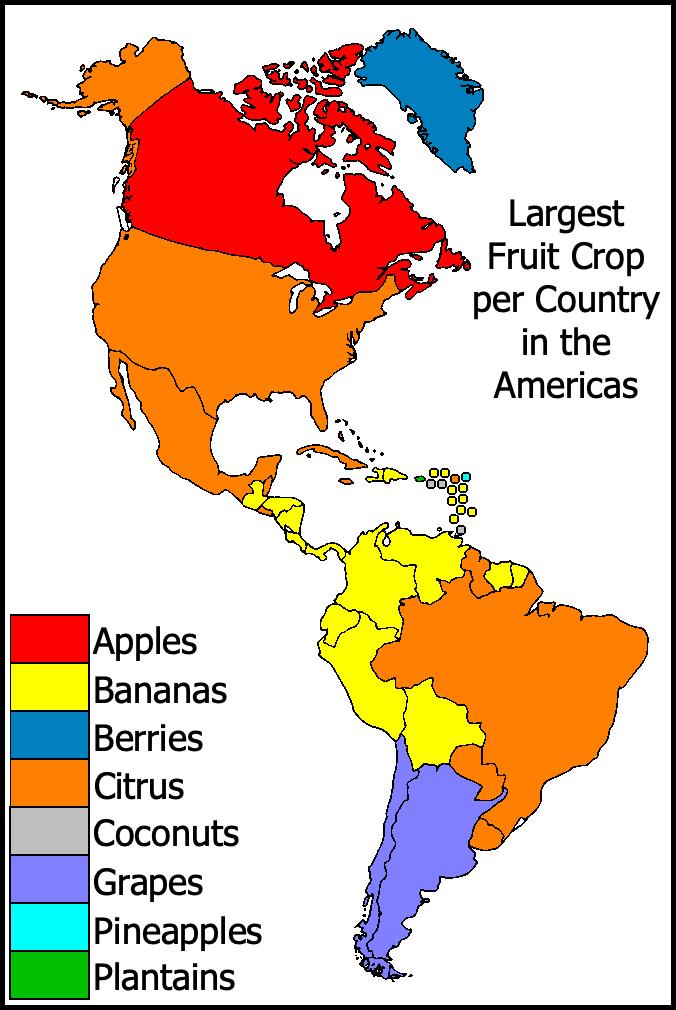Largest Fruit Crop per Country in the Americas Map


David Chen
Data Visualization Specialist
David Chen is an expert in transforming complex geographic datasets into compelling visual narratives. He combines his background in computer science ...
Geographic Analysis
What This Map Shows
The "Largest Fruit Crop per Country in the Americas" map visually represents the predominant fruit crops cultivated across various countries in North, Central, and South America. This visualization highlights which fruit crops hold economic significance in each nation, offering insights into agricultural practices, climate suitability, and food production trends in the region. From citrus fruits in the southern United States to bananas in Ecuador, the map serves as a fascinating lens through which we can examine the agricultural landscape of the Americas.
Deep Dive into Fruit Crops in the Americas
The Americas boast a rich diversity of climates and ecosystems, making it an ideal region for fruit cultivation. The continent's geography, ranging from tropical rainforests to arid deserts, influences the types of fruit crops that thrive in each area. For instance, citrus fruits—such as oranges, grapefruits, lemons, and limes—are primarily grown in warmer climates. These fruits are not only popular for their taste but also for their economic value, especially in countries like Brazil and Mexico, which lead the world in citrus production.
Interestingly, the United States also plays a significant role in citrus farming, particularly in Florida and California. Florida’s climate is particularly conducive to growing a variety of citrus crops, contributing to its status as a major producer. Meanwhile, in California, the production of oranges and lemons flourishes, showcasing the state's agricultural diversity.
Beyond citrus, the Americas are also known for their berry production. Countries like Chile and the United States are recognized for their high-quality blueberries and strawberries. The United States, especially in states like California and Oregon, has become a powerhouse in berry cultivation, exporting vast quantities to international markets. Notably, Chile's berry industry has gained traction in the export sector, making it a key player in the global fruit market.
In contrast, the northernmost part of the Americas, Greenland, presents a unique scenario. Here, wild berries—such as cloudberries, bilberries, and lingonberries—are gathered by locals and are emblematic of the region's subsistence lifestyle. Despite the harsh climate, these berries thrive and are a vital source of nutrition and income. Interestingly, there are reports of greenhouse-grown strawberries in southern Greenland, which, while not widely documented, reflect the potential for agricultural innovation even in extreme conditions.
Regional Analysis
When examining the map, it becomes clear that different regions of the Americas specialize in various fruit crops due to their unique climates and soil types. For example, tropical regions such as Central America are ideal for growing bananas and pineapples, with countries like Ecuador and Costa Rica leading in banana exports. Ecuador is particularly noteworthy, being one of the largest banana exporters globally, and its economy heavily relies on this fruit crop.
Similarly, the Caribbean islands tend to focus on crops like coconuts and mangoes, thriving in the warm, humid climates. The variety of crops reflects the agricultural practices and dietary preferences of each region. For instance, in Mexico, avocados have surged in popularity and production, especially given the increasing global demand for this fruit.
However, in colder regions like Canada, the fruit production landscape looks quite different. Apples are the dominant fruit crop here, with Ontario being a significant producer due to its favorable growing conditions. The diversity in fruit crops across regions emphasizes the adaptability of agriculture to local environments.
Significance and Impact
The significance of understanding the largest fruit crops in the Americas extends beyond mere statistics. Agriculture serves as the backbone of many economies in the region, providing jobs, food security, and export revenues. The fruit industry, in particular, plays a pivotal role in global trade, with countries like Chile and Mexico exporting large quantities of fruit to international markets.
Moreover, with ongoing discussions about climate change and sustainability, the agricultural practices surrounding fruit cultivation are evolving. Farmers are increasingly adopting sustainable practices to mitigate environmental impacts while meeting the demands of consumers. The future of fruit crops in the Americas will likely involve innovations in farming techniques, shifts in crop selection due to changing climates, and greater emphasis on organic and sustainable farming methods.
In conclusion, the "Largest Fruit Crop per Country in the Americas" map serves as a vital tool for understanding the agricultural landscape of this diverse continent. It highlights economic importance, regional specialties, and the intricate connection between geography and agriculture, offering a glimpse into the future of fruit production in the Americas.
Visualization Details
- Published
- August 10, 2025
- Views
- 98
Comments
Loading comments...